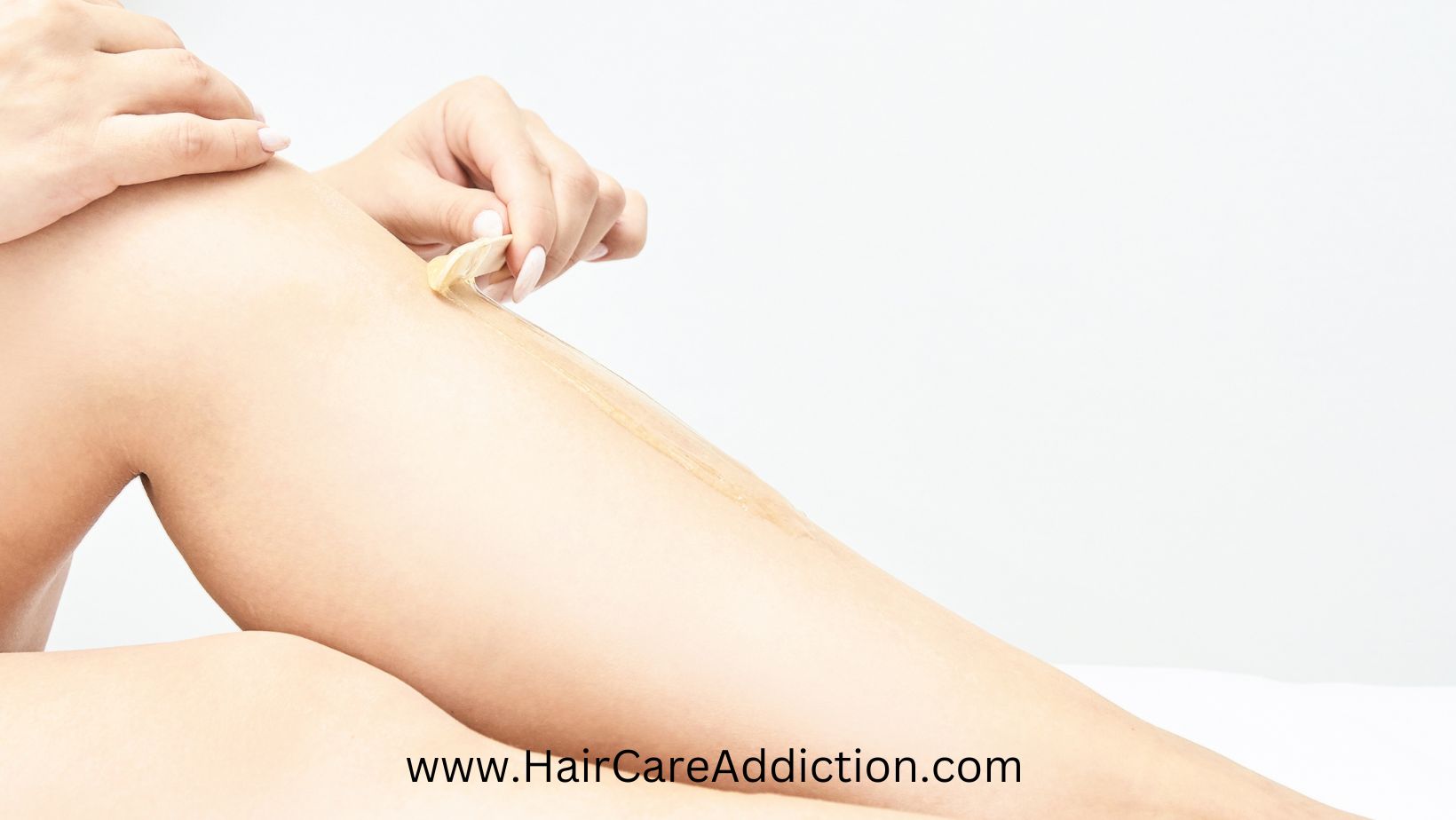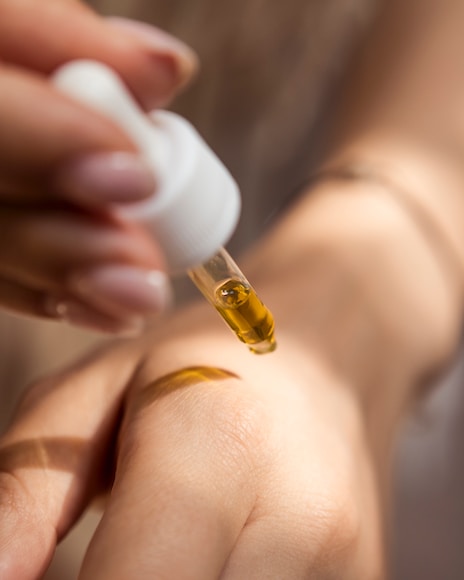Oil After Waxing: How to Choose and Apply the Best One for Your Skin

Waxing is a popular hair removal technique that can leave your skin smooth and hair-free for weeks.
Waxing, on the other hand, can cause redness, irritation, ingrown hairs, and dryness.
To avoid these issues and keep your skin healthy and happy after waxing, use the appropriate oil for your skin type and needs.
In this article, we’ll talke about benefits of using oil after waxing, best post waxing oil and how to use them. So, keep reading.
Why Use Oil After Waxing? (Benefits)
Oil is one of the best products to use after waxing because it has numerous skin benefits, including:
Moisturizing
Oil can help to restore your skin’s moisture balance, which may have been disrupted by waxing. Oil can also help to keep your skin hydrated by sealing in moisture.
Soothing
Oil can help to calm and reduce inflammation and redness caused by waxing. Oil can also be used to cool and refresh your skin.
Prevent Infection
By forming a barrier between your skin and the environment, oil can help to prevent infections and bumps. Oil has antibacterial and antifungal properties that can help fight off harmful microorganisms.
Removing Remaining Wax
Oil can aid in the removal of any wax residue left on your skin after waxing. Oil can also dissolve any wax that is too sticky or hard to remove with water or soap.
Conditioning
After waxing, oil can help soften and smooth your skin. Oil can also nourish your skin with essential fatty acids and antioxidants, which can improve the health and appearance of your skin.
Using oil after waxing can thus be an advantageous step in your skincare routine, providing hydration, soothing, and protection to your skin.
However, it is critical to select an oil that is appropriate for your skin type and does not irritate or clog your pores.
How to Choose the Best Oil for Your Skin Type and Needs?

Not all oils are created equal, and some may be better suited to your skin than others. Here are some things to think about when selecting the best oil for your skin type and needs:
- Skin type: Choose an oil that is appropriate for your skin type, whether it is dry, oily, combination, or sensitive. If you have dry skin, for example, choose a rich and moisturizing oil, such as coconut oil or olive oil. If you have oily skin, you should use a light, non-comedogenic oil, such as jojoba or argan oil.
- Skin condition: Think about any skin conditions or concerns you have, such as acne, eczema, or rosacea. If you have acne-prone skin, for example, you should use an oil with anti-inflammatory and antibacterial properties, such as tea tree oil or lavender oil. If you suffer from eczema or rosacea, use an oil with soothing and healing properties, such as chamomile or rosehip oil.
- Skin Preferance: When selecting an oil for your skin, you should also consider your personal preferences and comfort. If you prefer a light and fast-absorbing oil, choose one with a low viscosity and molecular weight, such as grapeseed oil or almond oil. If you prefer a rich and luxurious oil, go for one with a high viscosity and molecular weight, like avocado oil or shea butter.
How to Apply Oil After Waxing?
To get the most out of your oil after waxing, you should follow these steps:
The first step in caring for your skin after waxing is to thoroughly cleanse it.
This will get rid of any dirt, sweat, or bacteria that accumulated on your skin during the waxing process.
Use a gentle cleanser or soap that is appropriate for your skin type and needs. Rinse your skin thoroughly with lukewarm water and avoid using hot water, which may dry out your skin or cause inflammation.
The next step is to pat your skin dry with a clean towel.
Dry your skin gently without rubbing or scrubbing it, as this may cause irritation or damage. After waxing, you want your skin to be soft and smooth, not rough or red.
Third, while your skin is still damp, apply a thin layer of oil to it.
This allows the oil to penetrate deeper into the skin and seal in moisture.
Massage the oil into your skin in circular motions with your fingers or a cotton pad.
Any oil that suits your skin type and needs, such as coconut oil, jojoba oil, almond oil, or olive oil, can be used.
The fourth and final step is to wait a few minutes for the oil to be completely absorbed by your skin before dressing or applying any other products to your skin.
Touching or rubbing your skin should be avoided as this may disturb the oil or cause friction. After waxing, you want to let the oil work its magic and heal your skin.
Following these four simple steps will keep your skin healthy, hydrated, and smooth after waxing. This routine can be repeated whenever you wax your skin or whenever you feel your skin requires extra care.
How Often Should You Use Oil After Waxing?
The frequency with which you use oil after waxing is determined by your skin type and needs.
In general, use oil after every waxing session to help your skin recover and heal faster. However, depending on how your skin reacts to waxing, you may need to use oil more or less frequently.
If you have dry or sensitive skin, for example, you may need to use oil more frequently to keep it hydrated and calm.
Use oil once or twice a day for the first few days after waxing, then gradually reduce the frequency as your skin improves.
If you have oily or acne-prone skin, use oil less frequently to avoid clogging your pores and causing breakouts. You can use oil once a day or every other day for the first few days after waxing, then discontinue use as your skin returns to normal.
You should also consider how your skin feels and looks after applying oil.
You’re using the right amount and frequency of oil if your skin feels soft, smooth, and comfortable.
You are using too much or too often oil if your skin feels greasy, sticky, or heavy. If you have tight, dry, or irritated skin, you are using too little or too infrequently.
What Are Some of the Best Oils to Use After Waxing?
There are numerous oils that can be used after waxing, but the following are some of the most popular and effective:
Coconut oil
One of the most versatile and beneficial oils for your skin is coconut oil. It contains medium-chain fatty acids, which help to moisturize, protect, and heal your skin.
It also has antibacterial, antifungal, and anti-inflammatory properties that can help keep infections and bumps at bay. Coconut oil is good for all skin types, but it is especially good for dry and sensitive skin.
Tea tree oil
One of the most powerful and potent oils for your skin is tea tree oil. It has antibacterial, antifungal, and anti-inflammatory properties that can help fight off harmful microorganisms while also reducing inflammation.
Tea tree oil is suitable for oily and acne-prone skin, but it should be diluted with a carrier oil before application to avoid irritation or allergic reactions.
Olive oil
One of the most nourishing and hydrating oils for your skin is olive oil.
It contains oleic acid and antioxidants, which help to moisturize, protect, and repair your skin. It also has anti-inflammatory and soothing properties, which can help to soothe and calm your skin.
Olive oil is good for dry and mature skin, but it can be too heavy for oily or acne-prone skin.
Jojoba oil
Jojoba oil is one of the oils that is most similar to your natural sebum. It has the ability to balance your skin’s oil production and prevent excess sebum or dryness.
It also has nourishing, soothing, and healing properties that can nourish, soothe, and heal your skin. Jojoba oil is beneficial to all skin types, but it is especially beneficial to combination and sensitive skin.
Almond oil
is one of the gentlest and mildest oils for your skin. It hydrates, softens, and smoothes your skin by having moisturizing, anti-inflammatory, and emollient properties.
It also contains vitamin E and antioxidants, which can protect and improve the health and appearance of your skin.
Almond oil is beneficial to all skin types, but it is especially beneficial to normal and combination skin.
Baby Oil After Waxing
Baby oil is a mineral oil that can be used to remove wax residue and moisturize the skin following waxing.
It can, however, clog pores and cause breakouts or ingrown hairs, particularly in sensitive areas like the bikini line.
It is not advised for people who have acne-prone or oily skin.
Vitamin E Oil After Waxing
This is a natural oil that can aid in the healing and nourishment of the skin following waxing.
It has anti-inflammatory and antioxidant properties that can help to alleviate redness and irritation.
It can also aid in the prevention of scarring and hyperpigmentation caused by waxing.
Some people, however, may be allergic to vitamin E oil and develop rashes or itching. It is recommended that you perform a patch test before using it.
Azulene Oil After Waxing
This is a blue oil made from chamomile flowers. It is designed specifically for post-wax care because it is soothing, calming, and antibacterial.
It can aid in the prevention of infections, inflammations, and ingrown hairs following waxing. It can also remove wax residue from the skin, leaving it soft and smooth.
Fur Oil After Waxing
Fur oil is a natural oil blend that includes grapeseed, jojoba, clary sage, and tea tree.
It is intended to condition and hydrate the skin and hair following waxing, particularly in the pubic area.
It can aid in the prevention of ingrown hairs, bumps, and irritation. It also has a pleasant scent and quickly absorbs into the skin.
Sunflower Oil After Waxing
A light, non-greasy oil that can be used to moisturize and protect the skin after waxing. It contains vitamin E, linoleic acid, and antioxidants, which can aid in skin repair and regeneration.
It can also aid in the reduction of inflammation and redness following waxing.
It may not, however, be effective in removing wax residue or preventing ingrown hairs.
Grapeseed Oil After Waxing
Grapeseed oil: A light, non-comedogenic oil that can hydrate and soothe the skin after waxing.
It has anti-inflammatory, antimicrobial, and astringent properties that can aid in the prevention of infections, swelling, and bleeding following waxing.
It can also aid in the tightening of pores and the improvement of skin texture.
Olive Oil After Waxing
Olive oil: Another common household oil that can be used for post-wax care is olive oil.
It can aid in the removal of wax residue, the moisturization of the skin, and the prevention of dryness and flaking after waxing.
It also has antibacterial and anti-inflammatory properties, which can aid in the prevention of infections and irritations.
It may, however, be too heavy or oily for some skin types, resulting in clogged pores or breakouts.
Bio Oil After Waxing
A synthetic oil containing plant extracts and vitamins. Its primary application is to treat scars, stretch marks, uneven skin tone, and aging skin.
It can also aid in the moisturization and healing of the skin following waxing. It advertises itself as non-greasy and suitable for all skin types.
Some people, however, may have allergic reactions or sensitivity to some of its ingredients.
Argan Oil After Waxing
Argan oil is a natural oil derived from the kernels of the argan tree. It is well-known for its skin and hair moisturizing, nourishing, and anti-aging properties.
It can hydrate and soften the skin after waxing while also reducing inflammation and redness. By keeping the pores clean, it can also help prevent ingrown hairs, bumps, and infections.
Castor Oil After Waxing
Castor oil is a thick, sticky oil that can be used to remove wax residue and moisturize the skin after waxing.
It has antibacterial, antifungal, and anti-inflammatory properties that can aid in the prevention of infections, inflammations, and ingrown hairs following waxing.
It can also help to stimulate blood circulation and promote skin healing.
Peppermint oil After Waxing
This essential oil can be used to help cool and refresh the skin after waxing.
It has analgesic, antiseptic, and anti-inflammatory properties that can aid in pain relief, infection prevention, and swelling reduction after waxing.
However, it should be diluted with a carrier oil before applying to the skin because if used undiluted, it may cause irritation or burning sensations.
Conclusion
After waxing, oil is a great product to use because it can help your skin recover faster and better.
After waxing, oil can moisturize, soothe, protect, remove, and condition your skin. To get the best results, however, you must select the right oil for your skin type and needs, as well as apply it correctly and consistently.
We hope this article has given you a better understanding of how to choose and apply the best oil for your skin after waxing. If you have any questions or comments, please leave them in the comments section.


